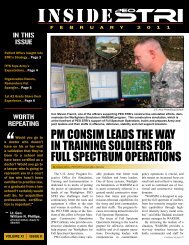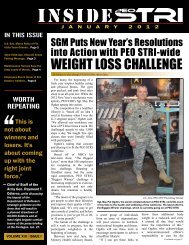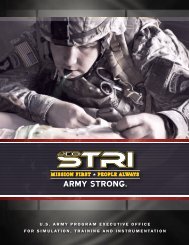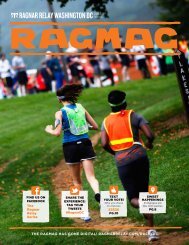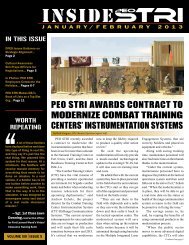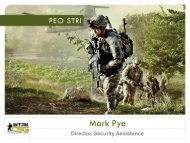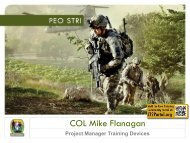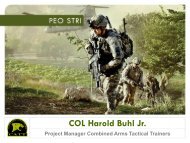InsIde - PEO STRI - U.S. Army
InsIde - PEO STRI - U.S. Army
InsIde - PEO STRI - U.S. Army
Create successful ePaper yourself
Turn your PDF publications into a flip-book with our unique Google optimized e-Paper software.
Former Senior Enlisted Advisor<br />
Welcomed Back to <strong>PEO</strong> <strong>STRI</strong><br />
After Serving in Afghanistan<br />
By Rick Gregory, A<strong>PEO</strong> Business Operations Support Staff<br />
English poet John Keats once<br />
said, “Nothing ever becomes real<br />
until it is experienced.”<br />
While Dave Lanham would<br />
agree with the basic premise of<br />
that statement, he said he firmly<br />
believes the training devices<br />
made available by <strong>PEO</strong> <strong>STRI</strong><br />
provide the most realistic experience<br />
our Soldiers can get prior to<br />
putting their boots on the ground<br />
in a combat environment.<br />
He should know. Besides being<br />
part of <strong>PEO</strong> <strong>STRI</strong> teams<br />
that oversee getting the training<br />
devices developed and to<br />
the Soldiers in the field, he has<br />
also donned his <strong>Army</strong> uniform<br />
and witnessed firsthand how that<br />
training has been put to action in<br />
overseas contingency operations<br />
in Afghanistan and Iraq.<br />
Lanham, a sergeant major in<br />
the Florida National Guard, has<br />
been with <strong>PEO</strong> <strong>STRI</strong> since 2004,<br />
having served first as the senior<br />
enlisted leader for PM CATT<br />
and then as <strong>PEO</strong> <strong>STRI</strong>’s senior<br />
enlisted advisor. He recently<br />
returned from a nine-month deployment<br />
in eastern Afghanistan<br />
at the Special Forces Advanced<br />
Operating Base where he assisted<br />
in managing the efforts to<br />
successfully perform operations<br />
in conjunction with the host nation<br />
and NATO forces.<br />
During his deployment, he and<br />
his team took the Village Stability<br />
Operations and Afghan Local<br />
Police programs from concept to<br />
reality while continuing to increase<br />
the Afghan National Security<br />
Force capability.<br />
Courtesy Photo<br />
Sgt. Maj. Dave Lanham, a strategic integrator with <strong>PEO</strong> <strong>STRI</strong>’s Business Operations Office,<br />
patrols the mountainside of eastern Afghanistan.<br />
With nearly 25 years of combined<br />
active <strong>Army</strong> and <strong>Army</strong><br />
National Guard service, including<br />
three tours with Operation<br />
Enduring Freedom in Afghanistan,<br />
one tour with Operation<br />
Iraqi Freedom and operations in<br />
several other regions, he speaks<br />
with authority when he says that<br />
the training Soldiers receive on<br />
simulated training devices is<br />
saving lives.<br />
“I believe the Training Aids,<br />
Devices, Simulators and Simulations<br />
(TADSS) have a significant<br />
impact on enhancing live<br />
training or replicating critical<br />
skills that you cannot duplicate<br />
in a live training environment<br />
without serious consideration to<br />
safety and resource management<br />
issues,” he said.<br />
Training Soldiers<br />
in critical<br />
medical care is<br />
one area Lanham<br />
speaks passionately<br />
about.<br />
“The ability to<br />
complete a needle<br />
decompression on<br />
a wounded Soldier<br />
is a proven<br />
lifesaving task,”<br />
he explained.<br />
“You can’t safely<br />
stick a needle in<br />
a Soldier’s chest<br />
cavity during a<br />
live training exercise,<br />
yet, thanks<br />
to the capabilities<br />
found in our Medical<br />
Simulation<br />
Training Centers,<br />
you can perform<br />
this task under realistic<br />
conditions until you have<br />
perfected the technique.”<br />
He also rhetorically asked<br />
how leaders can safely simulate<br />
a vehicle rollover without the use<br />
of a training device designed to<br />
do just that. “You can’t,” was his<br />
short answer. Training devices,<br />
he said, are an integral part of<br />
the <strong>Army</strong>’s training strategy and<br />
have been used since the days of<br />
the Roman Soldiers.<br />
“The Romans used a wooden<br />
training sword they called a rudis,<br />
which was designed to accurately<br />
replicate the weight<br />
and feel of a real sword to strike<br />
a man-sized wooden dummy<br />
known as a palus. TADSS will<br />
continue to have a positive impact<br />
on Soldiers for years to<br />
come.”<br />
Lanham, who rejoins <strong>PEO</strong><br />
<strong>STRI</strong> in August as a strategic<br />
program integrator in the Business<br />
Operations Office, is quick<br />
to point out that it is the collaboration<br />
of a lot of people that<br />
gets the training devices into the<br />
hands of the Soldiers.<br />
“At <strong>PEO</strong> <strong>STRI</strong>, we execute<br />
cradle-to-grave life-cycle management,”<br />
he said. “But, we<br />
could not do what we do without<br />
the folks who generate the need<br />
(the operational force), manage<br />
the requirement (Training and<br />
Doctrine Command), fight for<br />
the fiscal resources (Department<br />
of the <strong>Army</strong> Management Office<br />
- Training Simulations) and<br />
build the devices (industry). It’s<br />
truly a team effort.”<br />
<strong>PEO</strong> <strong>STRI</strong> also welcomes back<br />
Shannon Swain of PM CATT,<br />
who also recently returned from<br />
a deployment in Afghanistan.<br />
Inside <strong>STRI</strong> JUly 2011 5



